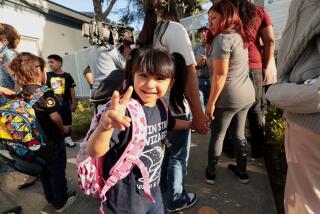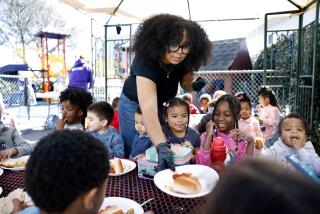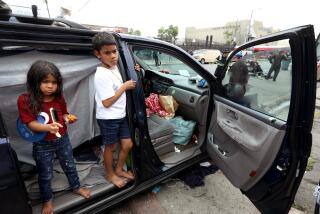Making a Schoolhouse Call : Doctor’s Visits Benefit Young Patients and Their Parents
- Share via
LONG BEACH — When Dr. Elisa Nicholas takes her stethoscope and antibiotics to an elementary school in Long Beach, she walks into a whirlwind.
Parents sit in the waiting room with sick babies bundled in their laps. The wail of an infant pierces the room. The school nurse ushers in a boy who has poked his eye with a pencil.
One school employee translates instructions to a parent in Cambodian. Another translates for the nurse in Spanish. Nicholas slips easily into Spanish on her own to explain to a girl how to use an inhaler. She holds another child still for her shots.
It’s 2 p.m. at International Elementary School’s fledgling health clinic.
Nicholas, a pediatrician who directs the Children’s Clinic in Long Beach, or members of the clinic staff go to the school two days a week to treat the students and their siblings. The Children’s Clinic is a nonprofit organization housed in Long Beach Memorial Hospital that provides low-cost health care for poor children.
With the cooperation of the school’s principal, Nicholas got a federal grant so the clinic’s pediatricians and nurse practitioners could spend Tuesdays and Fridays treating children where they spend most of their time--at school.
“This is where the children are,” Nicholas said. “We should be doing more in the schools.”
The staff sees about 10 children a day, giving out skin ointments, ear drops and other medicine and making sure the children get their immunizations.
International School--about 20 portable classrooms on a stretch of asphalt downtown on Long Beach Boulevard--serves predominantly poor Latino and Cambodian children. Before the clinic opened, 80% of the students had not received proper immunizations. And 65% of sick students referred by teachers to doctors never got treatment. Educators said parents often could not afford to take their children to a doctor or did not have transportation to another clinic.
“We found children were coming to school sick,” Principal Karen Hanafusa said.
Now the clinic helps treat those sick children and keep them out of the classroom.
“When they come when they’re sick, of course that’s going to affect everyone else,” said Jacqueline Peterson, a fifth-grade teacher. “They’re coughing all over the place. When you sit down with a child and the child is not feeling well and not getting adequate nutrition, that child doesn’t have the desire to (learn).”
Hanafusa and her energetic staff have used the addition of the clinic as an opportunity to improve their health curriculum. Using videos and performances by the “Health Nut,” a student or teacher dressed in an acorn costume, children will be taught about first aid and the importance of immunization.
The federal grant to the school clinic is $50,000 a year for five years. Part of it has been used to enroll some students in lifesaving and physical fitness programs at the city’s YMCA and to provide counseling for others at Long Beach’s Psychiatric Clinic for Youth.
When the money runs out, Nicholas and Hanafusa hope to fund both the clinic and health curriculum with endowments, corporate donations or assistance from community organizations.
At a time when public officials are encouraging innovative experiments in education and health care, the project at International School is being held up as a model for both.
“The government, the private sector and consumers are all saying at the same time, ‘Are there some ways we can work together to meet these children’s needs?’ ” said Susan Lordi, a consultant for the county’s school health programs. “I think this is a movement that’s going to grow.”
School-based clinics began opening in the early 1980s, but doctors and educators worked mostly with adolescents. Now, professionals are trying to target children just entering school and their younger brothers and sisters. Within the past year, five other elementary schools in Los Angeles County have started on-site clinics.
Since the clinic at International School opened in late February, the staff has seen nearly 100 children and has discovered some students with serious conditions, including a heart murmur.
And staff members point out that even common colds can lead to ear infections, which can develop into hearing problems and eventually learning disabilities if left untreated.
“There was a lot of lag time in getting children services,” said school nurse Sandy Morgan.
Eighty percent of the school’s students speak limited English, and their parents often cannot provide transportation to a doctor. Fifty percent of the school’s 650 students have been in the country less than two years.
Once children have been examined at the clinic, their names will be entered into the computer at the Children’s Clinic. This will allow the staff to keep their medical histories updated.
Nicholas said the families at the school often don’t have access to consistent health care.
“It’s not just the money. It’s can you get there? And when you get there, do you feel comfortable?” Nicholas said.
The school is convenient, and the staff gets to know the patients, parents said.
“I have to take two buses to get to the (hospital),” said Maria Aguilar, a mother of four children, one of whom attends fourth grade at International School. “But I come to the school to pick up my daughter, anyway. I can walk here.”
Alfreda Muhammad, the mother of eight and the school’s PTA president, plans to have all of her children examined at the school clinic.
“When you go to different doctors, they don’t know anything about you. You have to sit there for an hour and answer questions,” Muhammad said as she waited with her daughter.
“Here you see the same doctor, so the next time she’s sick I don’t have to explain her history again.”
More to Read
Sign up for Essential California
The most important California stories and recommendations in your inbox every morning.
You may occasionally receive promotional content from the Los Angeles Times.










